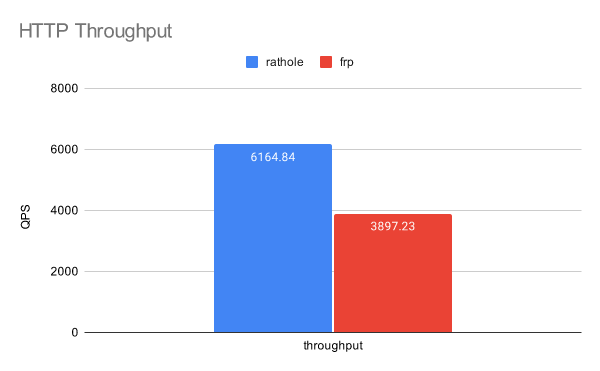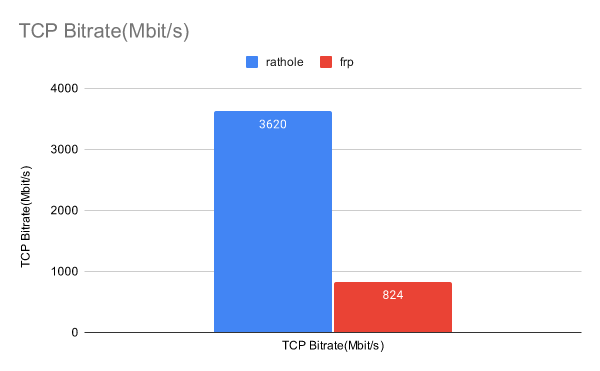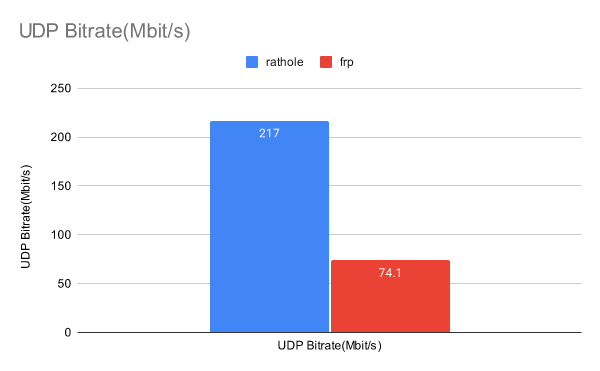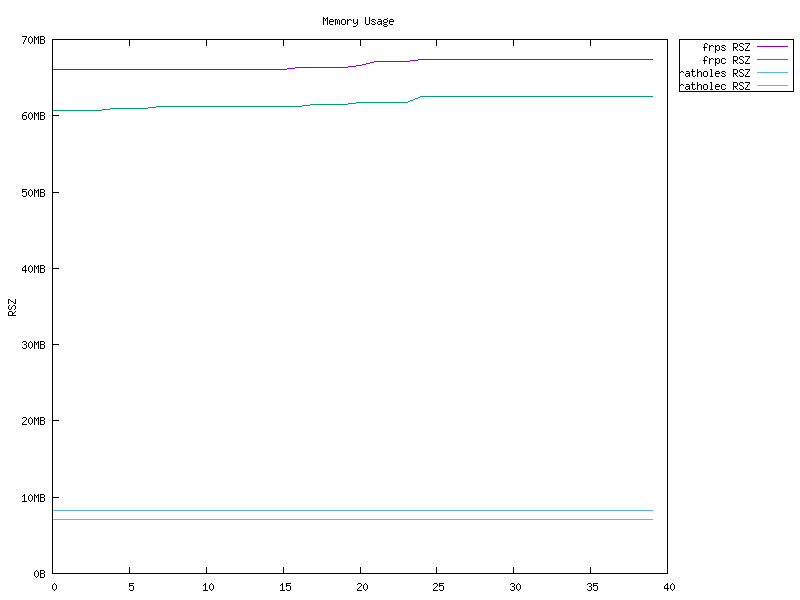21 个版本
| 0.5.0 | 2023年10月1日 |
|---|---|
| 0.4.8 | 2023年5月26日 |
| 0.4.7 | 2022年11月30日 |
| 0.4.2 | 2022年5月23日 |
| 0.2.0 | 2021年12月26日 |
#840 in 网络编程
每月196 次下载
用于 flowsnet
140KB
3K SLoC
rathole

一个安全、稳定且高性能的 NAT 穿越反向代理,用 Rust 编写
rathole,类似于 frp 和 ngrok,可以通过具有公网 IP 的服务器,将 NAT 背后的设备上的服务暴露到互联网上。
功能
- 高性能 比 frp 实现更高的吞吐量,处理大量连接时更稳定。见 基准测试
- 低资源消耗 比类似工具消耗更少的内存。见 基准测试。二进制文件可以 小至 ~500KiB 以适应如路由器等嵌入式设备的限制。
- 安全性 服务的令牌是强制性的,且服务级别的。服务器和客户端各自负责自己的配置。可选的 Noise 协议允许轻松配置加密。无需创建自签名证书!也支持 TLS。
- 热重载 可以通过热重载配置文件动态添加或删除服务。HTTP API 处于开发中。
快速入门
可以从发布页面获取全功能的rathole。或者,为了其他平台和最小化二进制文件,您可以从源代码构建。同时,也提供了Docker镜像。
rathole的使用与frp非常相似。如果您熟悉后者,那么配置对您来说非常简单。唯一的区别是服务的配置被分为客户端和服务器端,并且必须使用令牌。
要使用rathole,您需要一个公网IP的服务器,以及一个位于NAT后面的设备,其中包含一些需要暴露到互联网上的服务。
假设您家中有一个位于NAT后面的NAS,并且想将它的ssh服务暴露到互联网上
- 在具有公网IP的服务器上
创建server.toml并添加以下内容,并根据您的需要进行调整。
# server.toml
[server]
bind_addr = "0.0.0.0:2333" # `2333` specifies the port that rathole listens for clients
[server.services.my_nas_ssh]
token = "use_a_secret_that_only_you_know" # Token that is used to authenticate the client for the service. Change to a arbitrary value.
bind_addr = "0.0.0.0:5202" # `5202` specifies the port that exposes `my_nas_ssh` to the Internet
然后运行
./rathole server.toml
- 在位于NAT后面(您的NAS)的主机上
创建client.toml并添加以下内容,并根据您的需要进行调整。
# client.toml
[client]
remote_addr = "myserver.com:2333" # The address of the server. The port must be the same with the port in `server.bind_addr`
[client.services.my_nas_ssh]
token = "use_a_secret_that_only_you_know" # Must be the same with the server to pass the validation
local_addr = "127.0.0.1:22" # The address of the service that needs to be forwarded
然后运行
./rathole client.toml
- 现在客户端将尝试连接到服务器的
myserver.com端口2333,并且任何发送到myserver.com:5202的流量都将转发到客户端的端口22。
因此,您可以通过ssh myserver.com:5202来SSH连接到您的NAS。
在Linux上作为后台服务运行rathole,请查阅systemd示例。
配置
rathole可以根据配置文件的内容自动确定运行在服务器模式或客户端模式,如果只有[server]和[client]中的一个存在,就像快速入门中的示例一样。
但是,[client]和[server]块也可以放在一个文件中。然后在服务器端,运行rathole --server config.toml,在客户端,运行rathole --client config.toml以显式告诉rathole运行模式。
在深入了解完整配置规范之前,建议先浏览配置示例,以了解配置格式。
有关加密和transport块更详细的信息,请参阅传输。
以下是完整的配置规范
[client]
remote_addr = "example.com:2333" # Necessary. The address of the server
default_token = "default_token_if_not_specify" # Optional. The default token of services, if they don't define their own ones
heartbeat_timeout = 40 # Optional. Set to 0 to disable the application-layer heartbeat test. The value must be greater than `server.heartbeat_interval`. Default: 40 seconds
retry_interval = 1 # Optional. The interval between retry to connect to the server. Default: 1 second
[client.transport] # The whole block is optional. Specify which transport to use
type = "tcp" # Optional. Possible values: ["tcp", "tls", "noise"]. Default: "tcp"
[client.transport.tcp] # Optional. Also affects `noise` and `tls`
proxy = "socks5://user:passwd@127.0.0.1:1080" # Optional. The proxy used to connect to the server. `http` and `socks5` is supported.
nodelay = true # Optional. Determine whether to enable TCP_NODELAY, if applicable, to improve the latency but decrease the bandwidth. Default: true
keepalive_secs = 20 # Optional. Specify `tcp_keepalive_time` in `tcp(7)`, if applicable. Default: 20 seconds
keepalive_interval = 8 # Optional. Specify `tcp_keepalive_intvl` in `tcp(7)`, if applicable. Default: 8 seconds
[client.transport.tls] # Necessary if `type` is "tls"
trusted_root = "ca.pem" # Necessary. The certificate of CA that signed the server's certificate
hostname = "example.com" # Optional. The hostname that the client uses to validate the certificate. If not set, fallback to `client.remote_addr`
[client.transport.noise] # Noise protocol. See `docs/transport.md` for further explanation
pattern = "Noise_NK_25519_ChaChaPoly_BLAKE2s" # Optional. Default value as shown
local_private_key = "key_encoded_in_base64" # Optional
remote_public_key = "key_encoded_in_base64" # Optional
[client.transport.websocket] # Necessary if `type` is "websocket"
tls = true # If `true` then it will use settings in `client.transport.tls`
[client.services.service1] # A service that needs forwarding. The name `service1` can change arbitrarily, as long as identical to the name in the server's configuration
type = "tcp" # Optional. The protocol that needs forwarding. Possible values: ["tcp", "udp"]. Default: "tcp"
token = "whatever" # Necessary if `client.default_token` not set
local_addr = "127.0.0.1:1081" # Necessary. The address of the service that needs to be forwarded
nodelay = true # Optional. Override the `client.transport.nodelay` per service
retry_interval = 1 # Optional. The interval between retry to connect to the server. Default: inherits the global config
[client.services.service2] # Multiple services can be defined
local_addr = "127.0.0.1:1082"
[server]
bind_addr = "0.0.0.0:2333" # Necessary. The address that the server listens for clients. Generally only the port needs to be change.
default_token = "default_token_if_not_specify" # Optional
heartbeat_interval = 30 # Optional. The interval between two application-layer heartbeat. Set to 0 to disable sending heartbeat. Default: 30 seconds
[server.transport] # Same as `[client.transport]`
type = "tcp"
[server.transport.tcp] # Same as the client
nodelay = true
keepalive_secs = 20
keepalive_interval = 8
[server.transport.tls] # Necessary if `type` is "tls"
pkcs12 = "identify.pfx" # Necessary. pkcs12 file of server's certificate and private key
pkcs12_password = "password" # Necessary. Password of the pkcs12 file
[server.transport.noise] # Same as `[client.transport.noise]`
pattern = "Noise_NK_25519_ChaChaPoly_BLAKE2s"
local_private_key = "key_encoded_in_base64"
remote_public_key = "key_encoded_in_base64"
[server.transport.websocket] # Necessary if `type` is "websocket"
tls = true # If `true` then it will use settings in `server.transport.tls`
[server.services.service1] # The service name must be identical to the client side
type = "tcp" # Optional. Same as the client `[client.services.X.type]
token = "whatever" # Necessary if `server.default_token` not set
bind_addr = "0.0.0.0:8081" # Necessary. The address of the service is exposed at. Generally only the port needs to be change.
nodelay = true # Optional. Same as the client
[server.services.service2]
bind_addr = "0.0.0.1:8082"
日志记录
与许多其他Rust程序一样,rathole使用环境变量来控制日志级别。有info、warn、error、debug、trace可供选择。
RUST_LOG=error ./rathole config.toml
将以错误级别日志运行 rathole。
如果不存在 RUST_LOG,则默认日志级别为 info。
调整
从 v0.4.7 版本开始,rathole 默认启用 TCP_NODELAY,这应该有助于降低延迟并提高 rdp、Minecraft 服务器等交互式应用程序的性能。然而,这会略微降低带宽。
如果带宽更重要,可以使用 nodelay = false 来禁用 TCP_NODELAY。
基准测试
rathole 的延迟与 frp 类似,但可以处理更多的连接,提供更大的带宽,同时内存使用更少。
有关更多详细信息,请参阅单独的页面 Benchmark。
但是,不要以为 rathole 可以神奇地将您的转发服务速度提高几倍。 该基准是在本地回环中进行的,表示任务为 CPU 限制时的性能。如果网络不是瓶颈,则可以获得相当大的改进。遗憾的是,对许多用户来说并非如此。在这种情况下,主要的好处是资源消耗更低,而带宽和延迟可能不会有显著提高。




规划
- 配置的 HTTP API
Out of Scope 列出了未计划实现的功能及其原因。
依赖项
~11–27MB
~419K SLoC